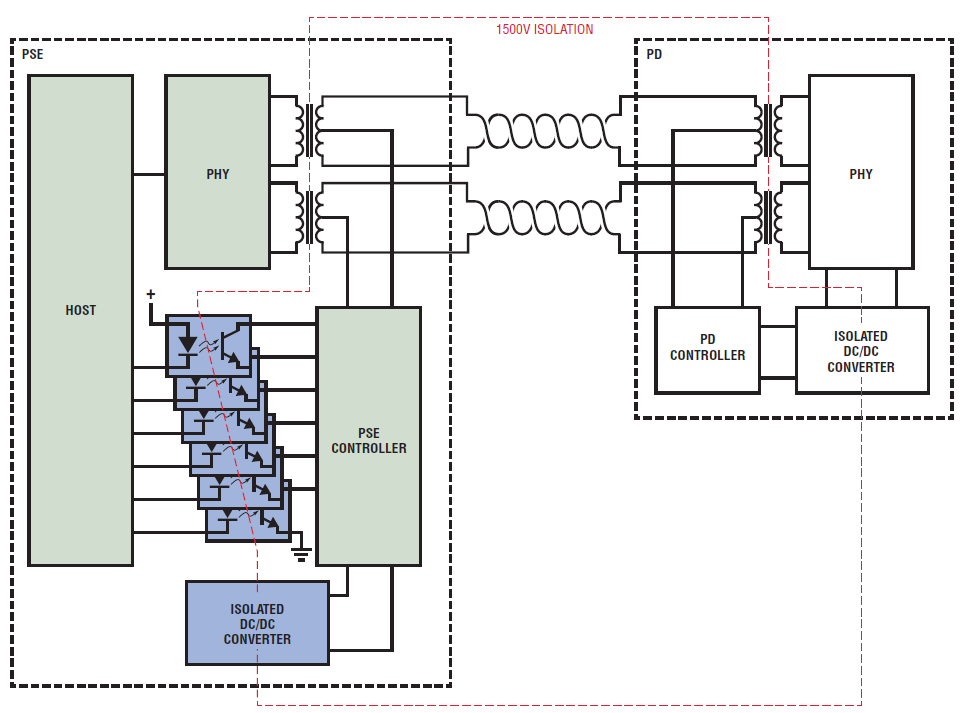Eliminate Opto-Isolators and Isolated Power Supply from Power over Ethernet Power Sourcing Equipment
Eliminate Opto-Isolators and Isolated Power Supply from Power over Ethernet Power Sourcing Equipment
Oct 1 2012
Power over Ethernet (PoE), is defined by the IEEE 802.3at specification to safely deliver application power over existing Ethernet cabling. Implementation of Power over Ethernet requires careful architecture and component selection to minimize system cost, while maximizing performance and reliability. A successful design must adhere to IEEE isolation requirements, protect the Hot Swap™ FET during short-circuit and overcurrent events, and otherwise comply with the IEEE specification.
The IEEE standard also defines PoE terminology. A device that provides power to the network is known as power sourcing equipment (PSE), while a device that draws power from the network is known as a powered device (PD).
The LTC4290/LTC4271 PSE controller chipset revolutionizes PSE architecture by deleting the customary digital isolation and removing an entire isolated power supply. Instead, the chipset employs a proprietary isolation protocol using a low cost Ethernet transformer pair, leading to a significant reduction in bill of materials cost.
The LTC4290/LTC4271 fourth generation PSE controller supports fully compliant IEEE 802.3at operation, while minimizing heat dissipation through the use of low RDS(ON) external MOSFETs and 0.25Ω sense resistors.
System Isolation Requirements
The PoE specification clearly lays out isolation requirements, guaranteeing ground loops are broken, maintaining Ethernet data integrity and minimizing noise in the PD application circuit.
Traditional PSE isolation architectures isolate the digital interface and power at the host-to-PSE controller interface. Digital isolation elements such as optocouplers are inherently expensive and unreliable. ICs capable of performing the isolation function are cost-prohibitive or do not support fast I2C transfer rates. In addition, isolated DC/DC converters needed to power the PSE logic increase board space and system cost.

Figure 1. Traditional PSE isolation schemes require a number of opto-isolators and a cumbersome, and costly isolated DC/DC converter. The LT4271-LT4290 solution shown in Figure 2 eliminates these components.

Figure 2. In contrast to the traditional scheme shown in Figure 1, a cleaner PSE architecture incorporates the LTC4290/LTC4271 chipset, achieving isolation without any opto-isolators and eliminating the need for a dedicated isolated DC/DC converter.
Isolation Made Easy
The LTC4290/LTC4271 chipset takes a different approach to PSE isolation (Figure 2) by moving all digital functions to the host side of the isolation barrier. This significantly reduces the cost and complexity of required components. There is no longer the need for a separate, isolated DC/DC power supply; the LTC4271 digital controller can use the host’s logic supply. The LTC4271 controls the LTC4290 using a transformer-isolated communication scheme. An inexpensive and ubiquitous Ethernet transformer pair replaces six opto-couplers. Intra-IC communication including port management, reset and fast port shutdown are encoded in a protocol designed to minimize radiated energy and provide 1500V of isolation.
Advanced Fourth Generation Features
Linear’s PSE family incorporates a wealth of PoE experience and expertise backed by well over 100 million shipped ports. This latest PSE generation adds features to a proven, field-tested product line. New features include field-upgradable firmware, future-proofing platforms that incorporate the LTC4290/LTC4271. Also new is optional 1-second current averaging, which simplifies host power management. The highest grade LTC4290A analog controller enables delivered PD power of up to 90W using the new LTPoE++™ physical classification scheme.
As with previous generations, a key benefit of the LTC4290/LTC4271 chipset architecture is the lowest-in-industry power dissipation, making thermal design significantly easier than designing with PSEs that integrate more fragile and higher RDS(ON) MOSFETs. System designers will appreciate the robustness provided by 80V-tolerant port pins. PD discovery is accomplished using a proprietary dual-mode, 4-point detection mechanism that ensures immunity from false PD detection.
Advanced power management includes prioritized fast shutdown, 12-bit per-port voltage and current read back, 8-bit programmable current limits and 7-bit programmable overload current thresholds.
A 1MHz I2C interface allows a host controller to digitally configure the IC or query port readings. “C” libraries are available to reduce engineering costs and improve time to market.
Conclusion
The LTC4290/LTC4271 builds on an established, robust lineup of Linear PSE solutions by slashing BOM costs while providing an overall best-in-field solution.
About the Authors
Heath Stewart is the Santa Barbara Design Center Manager for Linear Technology. Heath joined Linear in 2008 after 15 years in digital and mixed signal design. Prior, he received his degree from the University of Colorado –...
Related to this Article
Products
PRODUCTION
12-Port PoE/PoE+/LTPoE++ PSE Controller
PRODUCTION
8-Port PoE/PoE+/LTPoE++ PSE Analog Controller




















